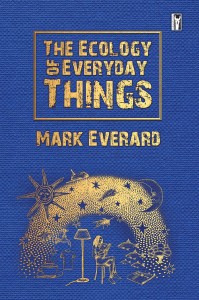 When we pick up a cup of tea, don a tee-shirt, eat a bowl of rice, read a newspaper, or draw a breath of fresh air or a bath of water, how conscious are we of where they come from, and how interconnected they and therefore we are with the dynamic and complex planetary ecosystems with which we co-evolved?
When we pick up a cup of tea, don a tee-shirt, eat a bowl of rice, read a newspaper, or draw a breath of fresh air or a bath of water, how conscious are we of where they come from, and how interconnected they and therefore we are with the dynamic and complex planetary ecosystems with which we co-evolved?
My newly published book, The Ecology of Everyday Things, does pretty much what the title says, considering the ecological roots, sources and fate of a diversity of ‘everyday things’ including those highlighted above. It considers how landscapes and waterscapes provide resources attracting and enabling the development of the communities in which we live, how even in space flight we have to find clever technological means to maintain our connections with terrestrial ecosystems, the important roles played by ‘unappealing creatures’ (wasps, slugs and woodlice) as well as addressing the question: “What’s so special about fish?”
Interconnections with water are a constant feature of all of these ‘everyday things’. This includes water in close proximity, for example in the way that rivers and their services have defined the trajectory and often the names of the places we live. Water is also plumbed both into and out of our homes, connecting us through technological trickery, from and to often more distant as well as local groundwater and surface water flows. However, we also make connections to water far more remotely, whether in space flight or via international trade in water-intensive commodities (rice, cotton, wood, mined products, biofuels and so forth), that we might take largely or entirely for granted in the ‘everyday things’ that surround our daily lives.
The Ecology of Everyday Things is no heavy environmentalist treatise or diatribe: look to some of my other books for that! (In particular, The Hydropolitics of Dams: Engineering or Ecosystems?, which takes a comprehensive view of our relationship – historically, now and into a hopefully sustainable future – with water.)
It is instead written to be accessible to a general readership, addressing familiar and ‘everyday’ things, designed to intrigue and inform enquiring minds and to promote a little more awareness, reflection and respect for the ‘ecology of everyday things’ that we might barely consider in our busy lives.
The Ecology of Everyday Things (Mark Everard, 2015) is published by Cultured Llama.
